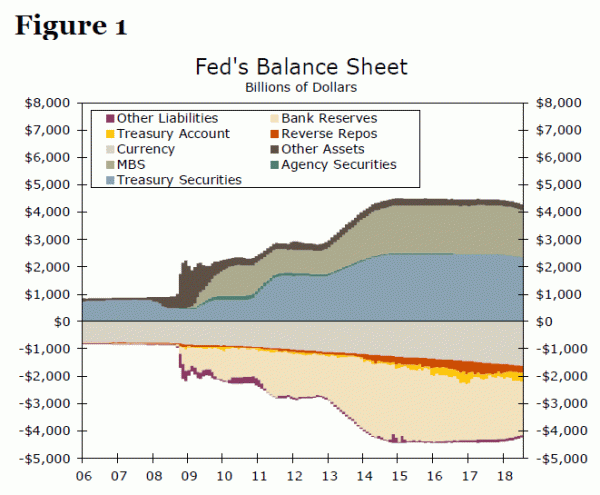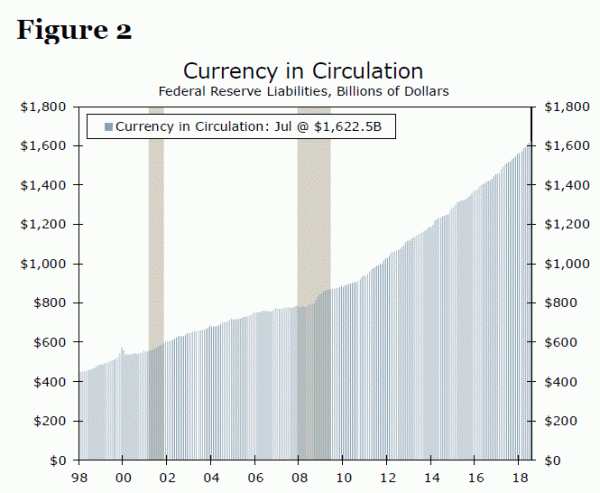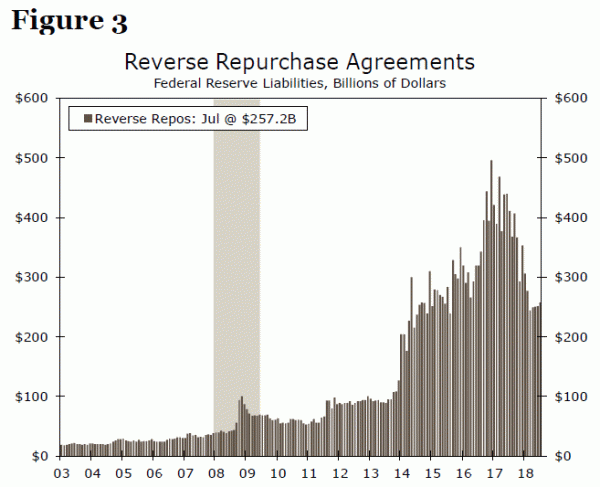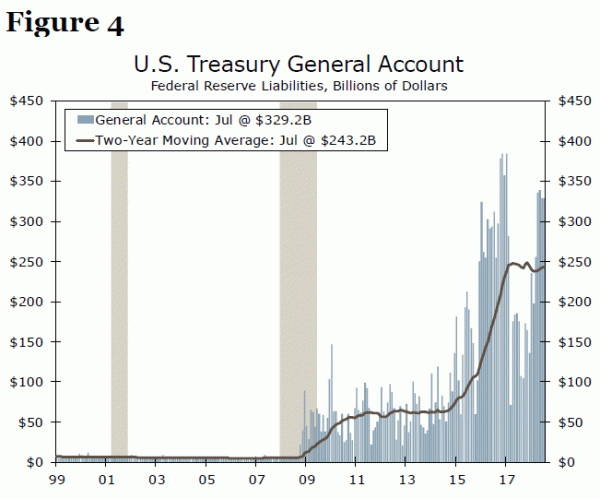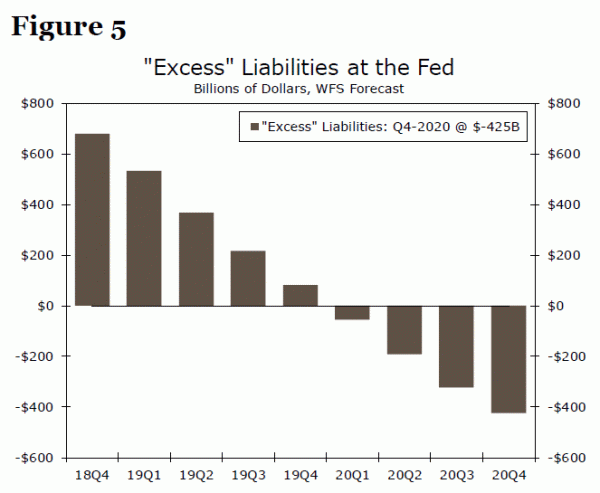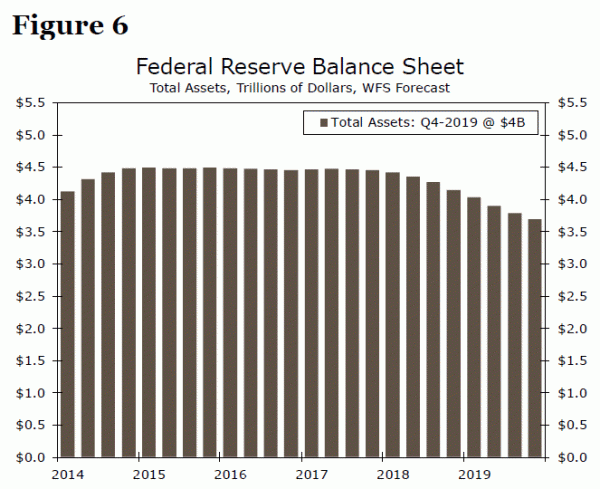Executive Summary
The size of the Fed’s balance sheet ballooned in the years after the financial crisis. Although the balance sheet is now slowly shrinking, it is clear that it will not return to its pre-crisis level. In the first of two reports, we delve into the liability side of the balance sheet. Over the past 10 years, there has been a natural increase in currency in circulation as well as the cash balances that the U.S. Treasury maintains at the Fed. In addition, changes in Fed operating procedure also have led to sizable increases in the amount of reverse repurchase agreements as well as the excess reserves that financial institutions desire to hold at the Fed. We estimate that the unwinding process will come to an end in late 2019/early 2020 when the balance sheet will total roughly $3.7 trillion. Thereafter, the balance sheet will start to grow again in line with organic growth in the Fed’s liabilities. The size of the Fed’s balance sheet will have implications for both short- and long-term interest rates in coming years, which we will discuss in Part II.
Fed Assets and Liabilities: Two Sides of the Same Coin
The balance sheet of the Federal Reserve, which totaled about $900 billion in autumn 2008, subsequently mushroomed to $4.5 trillion by early 2015 (Figure 1). Not only did the FOMC put in place a host of programs to prevent the financial system from collapsing during the darkest days of the financial crisis, it also initiated a program of quantitative easing after the target for the fed funds rate reached a range of 0.00 percent to 0.25 percent. Since then, the balance sheet has slowly receded to about $4.2 trillion at present, and many market participants are asking what its ultimate size will be once the shrinking process has come to an end.
In the first of two reports on this subject, we decompose the Fed’s liabilities to come up with an estimate of the ultimate size of the balance sheet. Ultimately, the Fed will match its assets against what it believes to be the appropriate size and mix of liabilities, making the liability side of the balance sheet key to estimating its size going forward. As shown in Figure 1, the bulk of the Fed’s liabilities consist of currency in circulation, which accounts for 38 percent of the Fed’s total liabilities at present, reverse repurchase agreements (6 percent), and the cash balances that the U.S. Treasury holds at the Fed (8 percent). Prior to the financial crisis, the reserves that financial institutions held at the Fed accounted for just a small share of the Fed’s liabilities. The Fed financed its sizeable purchases of Treasury securities and mortgage-backed securities (MBS) in the years following the financial crisis via a marked increase in the amount of reserves that financial institutions hold at the Fed. Today, those reserves account for 46 percent of the Fed’s liabilities. As we will describe in more detail subsequently, reserves of financial institutions will need to decline if the Fed wants to shrink its balance sheet in a meaningful way.
In the remainder of this report, we delve further into the four major components of the Fed’s liabilities. We then generate a forecast for the liability side of the Fed’s balance sheet. In our second report, we will decompose the asset side of the balance sheet and discuss implications for interest rates and financial markets.
Currency in Circulation
As shown in Figure 2, the amount of U.S. currency in circulation has doubled from about $800 billion before the Great Recession to more than $1.6 trillion at present.1 Nominal GDP has grown by roughly 40 percent over the past 10 years, so some of the increase in currency in circulation simply reflects the larger size of the economy. But, growth in nominal GDP does not explain the entire increase in currency outstanding, because the currency-to-GDP ratio has risen from about 5 percent prior to the Great Recession to about 8 percent today.
Low interest rates, which reduce the opportunity cost of holding cash, may have played a role in stoking the demand for currency in circulation, at least in the years in the immediate aftermath of the Great Recession. However, the currency-to-GDP ratio has continued to trend higher since 2015 although interest rates have risen, so it would appear that low interest rates cannot account for the continued increase in currency outstanding.
Another major factor to take into account is foreign demand for currency. There is not much “hard” data, but the Federal Reserve recently estimated that more than half of the dollars outstanding circulate in foreign countries.2 Therefore, changes in foreign demand for U.S. cash from abroad can have a significant effect on total demand for currency. Economic and political instability abroad has contributed to increased demand for U.S. cash, which is a likely explanation for a breakdown in the expected relationship between interest rates and currency use.3 A comparison with Canada is instructive. The currency-to-GDP ratio in Canada is about one-half of the comparable ratio in the United States despite similar payment systems and monetary policy stances between the two countries. U.S. dollars are widely held by foreigners; Canadian dollars are not.
To forecast the growth of currency outstanding going forward, we assume that the currency-to-GDP ratio will remain unchanged at 7.9 percent. We then use our forecast of nominal GDP growth in coming years to estimate that currency in circulation will rise by $20 billion or so per quarter in coming quarters.
Reverse Repurchase Agreements
Before it started the process of policy “normalization,” the Fed announced in September 2014 that it intended to use an overnight reverse repurchase agreement (ON RRP) facility as a supplementary policy tool to help control the federal funds rate and keep it in the target range set by the FOMC.4
In short, the reverse repurchase agreements help provide a floor on short-term interest rates by allowing investors to lend to the Fed on an overnight basis. The list of eligible counterparties is much broader for the ON RRP program than for the bank-dominated list of institutions eligible to earn interest on excess reserves.5 As long as a broad range of counterparties are eligible to participate in the program, lenders will have few incentives to lend below this rate. Participation in the program has waxed and waned depending on alternative short-term investment options. For example, Treasury bill issuance surged to start 2018; the $333 billion in net issuance in Q1-2018 was the most since late 2008 when the federal deficit exploded as the economy tanked. This significant increase in issuance subsequently put upward pressure on T-bill yields, increasing the spread between T-bills and the reverse repo rate offered by the Federal Reserve. If the spread between these close substitutes widens, lending money to the Fed will become less attractive, all else equal. While this Q1-2018 explosion of issuance in Treasury bills was somewhat of a perfect storm, the ominous outlook for the budget deficit in the years ahead should ensure a steady expansion of T-bill supply. Coming up with a precise forecast of the ON RRP facility is complicated by the many factors that determine demand for these financial instruments, so we assume that the amount of reverse repos outstanding remains unchanged at its current level of roughly $250 billion (Figure 3).
Treasury Cash Balances
Another major component of the Fed’s liabilities is the account maintained by the U.S. Treasury at the Federal Reserve. In addition to its numerous other responsibilities, the Fed acts as the U.S. government’s bank, helping to manage activities such as the government’s daily cash flows. Historically, the cash balance kept by the Treasury was rather small, with figures well below $50 billion before the Great Recession (Figure 4). In mid-2014, however, the Treasury undertook a review of its cash balance policy and determined that it would be prudent to maintain a larger cash balance. By mid-2015, the Treasury adopted the following policy: “Treasury will hold a level of cash generally sufficient to cover one week of outflows in the Treasury general account, subject to a minimum balance of roughly $150 billion.”6
Smoothing through the fluctuations caused by debt ceiling complications, a two-year moving average reveals that the cash balance sharply ramped up in 2015 and has averaged just shy of $250 billion over the past two years, roughly in line with average weekly outflows over that period (Figure 4). Thus, in light of this policy change, the U.S. Treasury’s general account at the Fed is likely to remain much larger in the future than it was before the Great Recession. This is yet another driver of a Fed balance sheet that will likely remain historically large in the years ahead. We assume the Treasury’s cash balance on average will remain unchanged at its recent average of $250 billion in coming years.
Reserves of Financial Institutions
As noted earlier, the reserves of financial institutions are the largest single liability on the Fed’s balance sheet. At present, these reserves total about $2 trillion, but only $190 billion are required reserves. In other words, the vast majority of the reserves that financial institutions hold at the Fed are excess reserves. Prior to the financial crisis, financial institutions wanted to hold few excess reserves, because they earned no interest on them. So, does this mean that excess reserves will eventually dwindle to essentially zero again? If so, the Fed could shrink its balance sheet significantly and manipulate the fed funds rate as it did before the Great Recession by altering the supply of excess reserves through open market operations.
In our view, financial institutions will desire to hold significant quantities of excess reserves, at least for the foreseeable future. For starters, the Fed now pays interest on excess reserves. Although financial institutions can earn more than the 1.95 percent that the Fed currently pays for excess reserves, the “loan” to the Fed is risk free. If, as we forecast, the Fed continues to raise rates (including the interest rate that it pays on excess reserves), then the quantity demanded of excess reserves will increase, everything else equal.
Second, regulatory changes have given financial institutions a reason to hold excess reserves. Specifically, large banks must meet a liquidity coverage ratio (LCR). In short, the LCR requires that large banks hold a certain level of highly liquid assets to meet their short-term obligations in a period of significant liquidity stress.7 There are multiple buckets into which high-quality liquid assets are grouped, and reserves held at the Fed are counted in the safest and most liquid “Level 1” bucket. In addition, reserves at the Fed are in theory unlimited, while the supply of other short-term liquid assets, such as Treasury bills or highly-rated commercial paper, can ebb and flow based on exogenous factors such as the U.S. budget deficit. From a regulatory standpoint, this fixed level of demand must be met somehow, and excess reserves provide a useful safety net to ensure this need is met. Thus, banks now not only earn a competitive market rate on their excess reserves, but also have a strong regulatory incentive to hold excess reserves, two noteworthy changes from the pre-2008 period.
Third, the Fed may want financial institutions to hold excess reserves due to monetary policy implementation. The current system of using interest on excess reserves and ON RRPs to keep the fed funds rate in a target range allows the Fed to keep quantitative easing readily accessible should the need arise. If the Fed were to wind down excess reserves to a level where the old system of open market operations sets the fed funds rate, the Fed would need to bounce back and forth between operational systems should it desire to utilize QE again, which policymakers and financial markets might find unsettling. Furthermore, while there have been some speed bumps along the path of normalization (a topic we will discuss more in Part II), the current monetary policy transmission system has been broadly successful at achieving its main policy goal of pulling short-term interest rates higher throughout the economy.
Data on the amount of reserves that individual institutions hold at the Fed are not readily available for all large banks that are covered by the LCR. However, we do have a detailed breakdown of the LCR buckets for three of the largest banks in the United States from their 10-Qs. We assume that the other large banks hold reserves at the Fed in the same proportion to their overall LCR holdings as the three banks for which we have data. This assumption allows us to estimate the total reserves that banks currently hold at the Fed for LCR purposes. Our back-of-the-envelope calculations suggest that total bank reserves exceed the reserves that are held for LCR purposes by about $700 billion at present, which gives the Fed some room to shrink its balance sheet further. Of course, reserve holdings for LCR purposes will increase in coming quarters as the deposit bases of banks continue to grow.
When and Where Will the “Terminal” Size Be Reached?
Adding up our forecasts of currency in circulation, the amount of ON RRPs outstanding, the Treasury’s cash balance, and bank reserves for LCR purposes gives us a forecast of the liability side of the Fed’s balance sheet. As noted earlier, we estimate that there are nearly $700 billion worth of “excess” liabilities on the Fed’s balance sheet at present (Figure 5). Of course, liabilities must equal assets at all times. But those “excess” liabilities largely reflect excess reserves that banks do not need or necessarily want at present. Indeed, the size of the Fed’s balance sheet has declined by about $270 billion since early 2015 as the excess reserves held by the commercial banking system have dropped by about $750 billion over that period (currency in circulation and the Treasury’s account at the Fed have both risen over the past three years).
“Excess” liabilities will shrink in line with the asset side of the balance sheet. The Fed is currently allowing a maximum of $24 billion worth of Treasury securities and $16 billion worth of MBS to roll off its balance sheet each month. These maximum amounts will increase to $30 billion and $20 billion respectively in October, and then remain at those levels as long as the shrinkage of the balance sheet is underway, but our analysis shows that that process will come to an end in another year or so. Specifically, our calculations show that “excess” liabilities will be exhausted by 2019/early 2020, at which point the Fed’s balance sheet would total roughly $3.7 trillion (Figure 6). Starting in 2020, the balance sheet would need to increase again due, at least in part, to continued growth in the volume of currency in circulation. The likely need of the Department of the Treasury to gradually raise its cash account would also put upward pressure on the size of the Fed’s balance sheet at that time.
Conclusion
The size of the Fed’s balance sheet ballooned from less than $1 trillion prior to the financial crisis to a peak of $4.5 trillion in early 2015. The size of the balance sheet remained more or less unchanged through 2016 and 2017, but it has been shrinking noticeably in recent months. Our analysis suggests that the balance sheet will shrink further over the next year or so, but that the process will come to an end in late 2019/early 2020 when the balance sheet would total about $3.5 trillion. Unless regulations and the operating procedure of the Fed revert back to their precrisis modes, which we do not believe will happen anytime soon, banks will desire to hold excess reserves at the Fed. Furthermore, the Fed will naturally have higher liabilities than it did 10 years ago due to the increase in demand for currency and higher cash balances of the U.S. Treasury.
We acknowledge, however, that there is some uncertainty surrounding our estimate of when the unwinding process of the balance sheet comes to an end. The results of our analysis depend heavily on our assumptions about the currency-to-GDP ratio going forward, Treasury cash balances, ON RRPs outstanding and bank’s demand for excess reserves. There is also some uncertainty on the asset side of the Fed’s balance sheet. As we will discuss in more detail in our second report, the Fed’s MBS holdings, which total about $1.7 trillion at present, may not roll off as quickly as we currently project. A larger-than-expected increase in mortgage rates, should it occur, would discourage refinancing, thereby slowing MBS redemptions. Although the unwinding of the balance sheet may take longer than we currently envision, the Fed’s balance sheet will remain sizable. As we discuss in our next report, the significant holdings of Treasury securities that the Fed is likely to maintain will have implications for both short- and long-term interest rates going forward.
1 Paper currency in the United States contains the label “Federal Reserve Note” at the top of each note.
2 Ruth Judson, “The Death of Cash? Not So Fast: Demand for U.S. Currency at Home and Abroad, 1990- 2016,” (paper presentation, Deutsche Bundesbank International Cash Conference 2017, War on Cash: Is There a Future for Cash?, Island of Mainau, Germany, April 26, 2017).
3 Thomas Haasl, Anna Paulson & Sam Shulhofer-Wohol, “Understanding the Demand for Currency at Home and Abroad,” Chicago Fed Letter 396 (2018).
4 For a timeline of FOMC communications related to policy normalization, see the following https://www.federalreserve.gov/monetarypolicy/policy-normalization.htm
5 For a full-list of eligible reverse repo counterparties, see the following from the Federal Reserve Bank of New York https://www.newyorkfed.org/markets/rrp_counterparties.html
6 U.S. Treasury. “Quarterly Refunding Statement of Acting Assistant Secretary for Financial Markets Seth B. Carpenter.” May 6, 2015. https://www.treasury.gov/press-center/press-releases/Pages/jl10045.aspx
7 For a brief summary of the LCR, see this piece from the Bank for International Settlements https://www.bis.org/fsi/fsisummaries/lcr.htm




